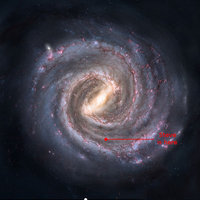The Drake Equation (Le Guin inspired)
My original post on this subject combined an appreciation of Ursula Le Guin’s The Left Hand of Darkness with my layman’s blather about the Drake Equation. The post was grossly overweight and has calved. See the post that birthed this part two at Ursula le Guin and the Drake Equation.
Drake’s equation: N = R* • fp • ne • fl • fi • fc • L
 Drake’s famous equation was developed as a framework for estimating N: the number of advanced civilizations in our Milky Way galaxy we might expect to be detectable by radio telescopes. It was used by enthusiasts of the Search for Extra Terrestrial Intelligence (SETI) to justify their search.[1] Good estimates for most of its variables do not exist, so as a formula it is pretty close to worthless. However, as a thought-provoking tool, I find it useful. Reading news accounts of Petigura’s paper while immersed in Le Guin’s populous Milky Way galaxy certainly brought it to mind.
Drake’s famous equation was developed as a framework for estimating N: the number of advanced civilizations in our Milky Way galaxy we might expect to be detectable by radio telescopes. It was used by enthusiasts of the Search for Extra Terrestrial Intelligence (SETI) to justify their search.[1] Good estimates for most of its variables do not exist, so as a formula it is pretty close to worthless. However, as a thought-provoking tool, I find it useful. Reading news accounts of Petigura’s paper while immersed in Le Guin’s populous Milky Way galaxy certainly brought it to mind.
We do seem to have pretty good estimated values for the first three variables on the right side of Drake’s equation
R* = average rate of star formation in our galaxy
fp = fraction of those stars that harbor planets
ne = planets per these stars in the “habitable zone”
and the fourth variable
fl = the fraction of those planets that develop life
may be well within our grasp. The launch of the James Webb Space Telescope is scheduled for 2018. It will be a very significant upgrade on the Hubble Space Telescope (this is probably a huge understatement). Its capabilities will include the ability to detect chemical signatures of life from planets orbiting stars in our galaxy.
We have no good estimates of values for the right-most three variables in the equation: fraction of planets with life that develop intelligent civilizations, fraction of these that develop technology that releases detectable signs of their existence into space (radio waves, for example) and the length of time for which these civilizations release these signals. We are not likely, as far as I can tell, to develop good estimates anytime soon.
Some variations on Drake’s equation seek to estimate the number of planets that may harbor life, regardless of whether or not this life is intelligent and emitting radio frequencies at the right time for us to detect them. Some may be solvable in the very near future. One such variation has been proposed by Sara Seager. Her equation seeks to solve for N = number of observed planets for which we will detect biochemical signs of life:
N = N* • FQ • FHZ • Fo • FL • FS
The first two unknowns on the right side of her equation specify the number of “quiet” (suitable) stars we are able to observe. The last four boil down to: how many rocky planets in habitable zones are observable, have life, and produce detectable gases? (See Wikipedia for an explanation of this equation.)
Seager seeks to predict the number of planets for which we will detect biosignature gases.[2] But the interesting question is, how many of these planets may exist in our galaxy? If expected observations are made in the course of the James Webb Space Telescope mission, Seager’s N will be known. This number, divided by the number of qualifying planets observed will give us new number: the percentage of qualified planets observed that emit detectable levels of biosignature gases. I will call them “gassers.” We can then construct a new, simple equation:[3]
N = nq • pg
where N = number of qualifying planets in our galaxy that emit detectable levels of biosignature gases
nq = number of qualifying planets (using Petigura’s criteria)
pg = percentage of observed qualifying planets that are “gassers”
We have a number for our first variable. From Petigura we can pencil in 40 billion.[4] So
N = (4 • 1010) • pg
 Even a low non-zero value for the percentage of planets observed from which biosignature gases are detected will yield significant numbers of presumed “life-harboring” planets. If, say, a meaningful number of planets can be observed and detections are realized from .001% of them (one in every 100,000), then the predicted number of gassers in our galaxy would be 400,000! Amazing. This is just our galaxy. How many (presumably) fecund planets might be a found among the 6.8 sextillion candidate planets in the Universe?! [5]
Even a low non-zero value for the percentage of planets observed from which biosignature gases are detected will yield significant numbers of presumed “life-harboring” planets. If, say, a meaningful number of planets can be observed and detections are realized from .001% of them (one in every 100,000), then the predicted number of gassers in our galaxy would be 400,000! Amazing. This is just our galaxy. How many (presumably) fecund planets might be a found among the 6.8 sextillion candidate planets in the Universe?! [5]
Ekumen?
What does all this really have to do with Ursula Le Guin’s galactic federation, the Ekumen? Nothing, really. In the galaxy as she imagines it, life had only to arise independently on one planet (Hain, which then “seeded” other candidate worlds), and it is hard to imagine that the near-lightspeed travel required to bind together such a federation will ever be possible. We aren’t likely to join any such federation anytime soon.
It seems very likely to me, though, that we do indeed live in a galaxy (and a universe) where life is widespread. Confirming that it is will be a mind-blowing event for mankind. Perhaps even one that leads to a greater sense of the unity of the life that exists here on our small rock. I can’t expect to be around to experience it, but I am filled with the hope that my wife, children and grandchildren might.
—
Notes
- I used to participate in the SETI-at-home project, running its screensavers at home and at work. It still exists! I am ashamed to have dropped out, except that it is probably more responsible today to allow our computers to hibernate rather than consume power 24x7 crunching numbers, despite the potential payoff (given the vanishingly long odds of its success). [^]
- For more than you ever wanted to know about the detection of biosignature gases and what their detection might mean, see the MIT paper “Detectability of biosignature gases in the atmospheres of terrestrial exoplanets”. [^]
- I don’t mean to imply here that I have developed anything like an original equation with my obvious statement about the implications of the upcoming James Webb mission. In a finite universe, there has to be some theoretical limit to my ego. [^]
- I should point out that the Petigura paper never specifies that 40 billion earth-like planets exist in our galaxy. The paper posits that 22% of Sun-like stars harbor such planets. Since it was recently demonstrated that “tidally-locked planets have low enough surface temperatures to be habitable,” red dwarfs are also thought to be candidate stars. The 40 billion number comes from extending this 22% figure to include red dwarfs, the most numerous category of star in our galaxy. This may or may not be a valid extrapolation. In any case, I have seen estimates reported that range from as low as 8.8 billion (NBC news) to as high as 60 billion (Universe Today). The 40 billion figure I have fixed upon seems to be the one receiving the most press (which says nothing about its merit). [^]
-
There are thought to be more than 170 billion galaxies in the observable universe, and I can’t help but speculate. If our galaxy is somewhat average, and the 22% rule can be extrapolated across the universe (and I include red dwarfs; see footnote #5 above), then the number of Earth-like planets orbiting in the habitable zones of hospitable stars might be 170 billion times 40 billion. A scientist might write the product of this calculation as
68 • 1020
a rube like me might write this as
6,800,000,000,000,000,000,000
Either way, that is 6.8 sextillion (technically, a metric boatload) of Earth-like planets orbiting in “Goldilocks zones” around hospitable stars! [^]
